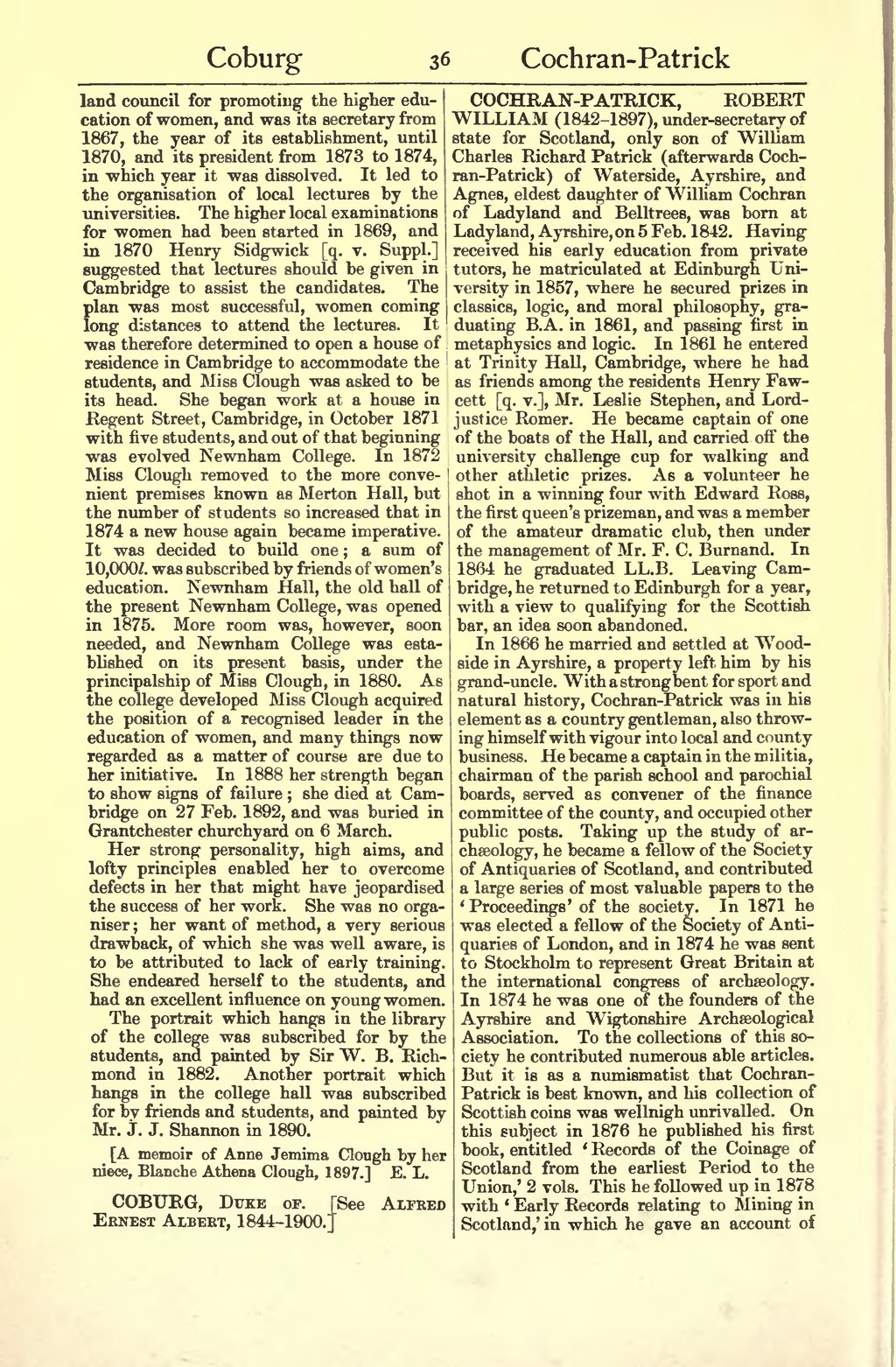land council for promoting the higher education of women, and was its secretary from 1867, the year of its establishment, until 1870, and its president from 1873 to 1874, in which year it was dissolved. It led to the organisation of local lectures by the universities. The higher local examinations for women had been started in 1869, and in 1870 Henry Sidgwick [q. v. Suppl.] suggested that lectures should be given in Cambridge to assist the candidates. The plan was most successful, women coming long distances to attend the lectures. It was therefore determined to open a house of residence in Cambridge to accommodate the students, and Miss Clough was asked to be its head. She began work at a house in Regent Street, Cambridge, in October 1871 with five students, and out of that beginning was evolved Newnham College. In 1872 Miss Clough removed to the more convenient premises known as Merton Hall, but the number of students so increased that in 1874 a new house again became imperative. It was decided to build one; a sum of 10,000l. was subscribed by friends of women's education. Newnham Hall, the old hall of the present Newnham College, was opened in 1875. More room was, however, soon needed, and Newnham College was established on its present basis, under the principalship of Miss Clough, in 1880. As the college developed Miss Clough acquired the position of a recognised leader in the education of women, and many things now regarded as a matter of course are due to her initiative. In 1888 her strength began to show signs of failure; she died at Cambridge on 27 Feb. 1892, and was buried in Grantchester churchyard on 6 March.
Her strong personality, high aims, and lofty principles enabled her to overcome defects in her that might have jeopardised the success of her work. She was no organiser; her want of method, a very serious drawback, of which she was well aware, is to be attributed to lack of early training. She endeared herself to the students, and had an excellent influence on young women.
The portrait which hangs in the library of the college was subscribed for by the students, and painted by Sir W. B. Richmond in 1882. Another portrait which hangs in the college hall was subscribed for by friends and students, and painted by Mr. J. J. Shannon in 1890.
[A memoir of Anne Jemima Clough by her niece, Blanche Athena Clough, 1897.]
COBURG, Duke of. [See Alfred Ernest Albert, 1844–1900.]
COCHRAN-PATRICK, ROBERT
WILLIAM (1842–1897), under-secretary of state for Scotland, only son of William Charles Richard Patrick (afterwards Cochran-Patrick) of Waterside, Ayrshire, and Agnes, eldest daughter of William Cochran of Ladyland and Belltrees, was born at Ladyland, Ayrshire, on 5 Feb. 1842. Having received his early education from private tutors, he matriculated at Edinburgh University in 1857, where he secured prizes in classics, logic, and moral philosophy, graduating B.A. in 1861, and passing first in metaphysics and logic. In 1861 he entered at Trinity Hall, Cambridge, where he had as friends among the residents Henry Fawcett [q. v.], Mr. Leslie Stephen, and Lord-justice Romer. He became captain of one of the boats of the Hall, and carried off the university challenge cup for walking and other athletic prizes. As a volunteer he shot in a winning four with Edward Ross, the first queen's prizeman, and was a member of the amateur dramatic club, then under the management of Mr. F. C. Burnand. In 1864 he graduated LL.B. Leaving Cambridge, he returned to Edinburgh for a year, with a view to qualifying for the Scottish bar, an idea soon abandoned.
In 1866 he married and settled at Woodside in Ayrshire, a property left him by his grand-uncle. With a strong bent for sport and natural history, Cochran-Patrick was in his element as a country gentleman, also throwing himself with vigour into local and county business. He became a captain in the militia, chairman of the parish school and parochial boards, served as convener of the finance committee of the county, and occupied other public posts. Taking up the study of archæology, he became a fellow of the Society of Antiquaries of Scotland, and contributed a large series of most valuable papers to the 'Proceedings' of the society. In 1871 he was elected a fellow of the Society of Antiquaries of London, and in 1874 he was sent to Stockholm to represent Great Britain at the international congress of archæology. In 1874 he was one of the founders of the Ayrshire and Wigtonshire Archæological Association. To the collections of this society he contributed numerous able articles.
But it is as a numismatist that Cochran-Patrick is best known, and his collection of Scottish coins was wellnigh unrivalled. On this subject in 1876 he published his first book, entitled 'Records of the Coinage of Scotland from the earliest Period to the Union,' 2 vols. This he followed up in 1878 with 'Early Records relating to Mining in Scotland,' in which he gave an account of
